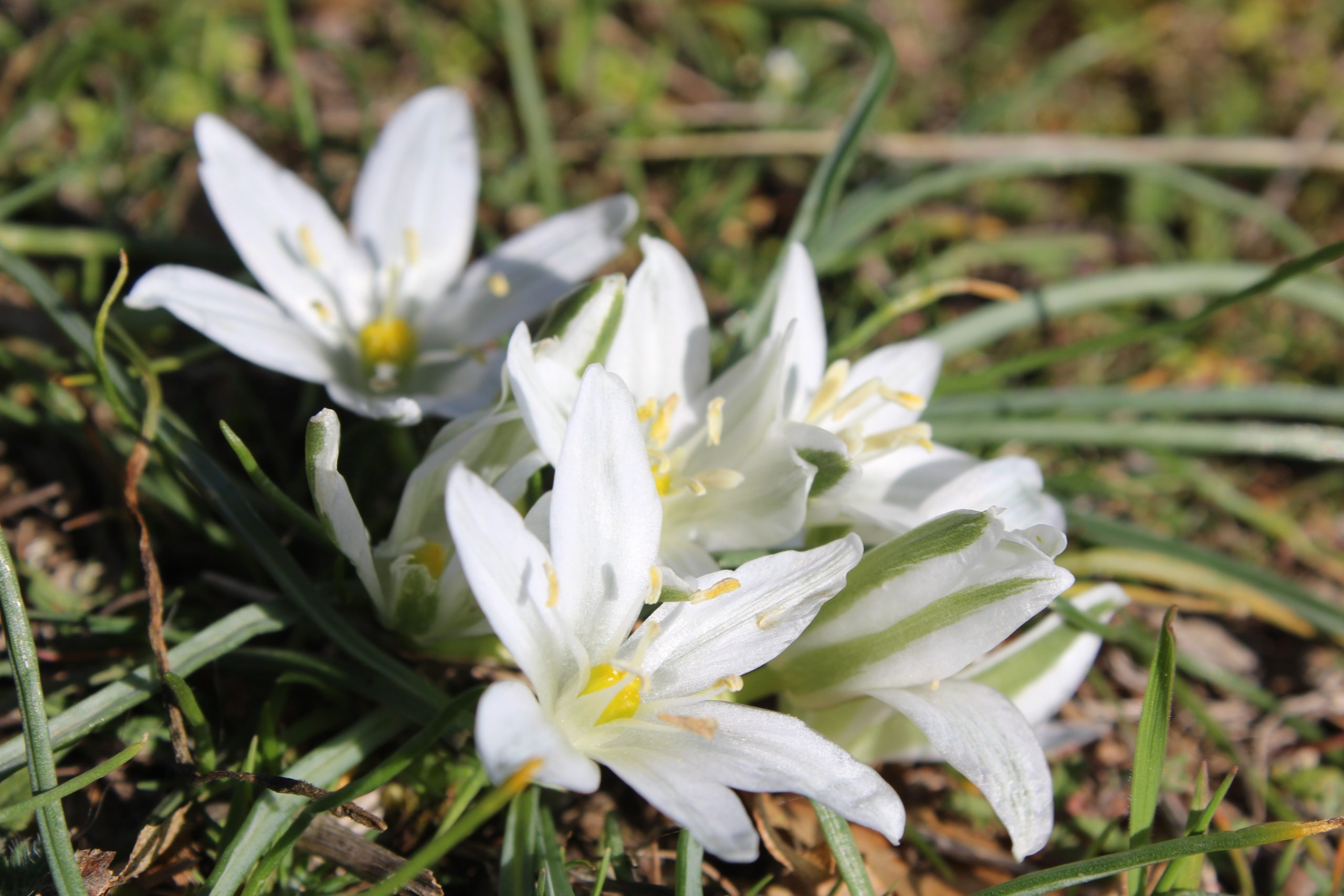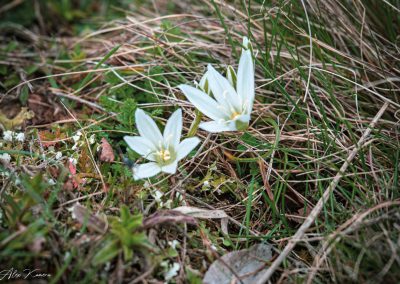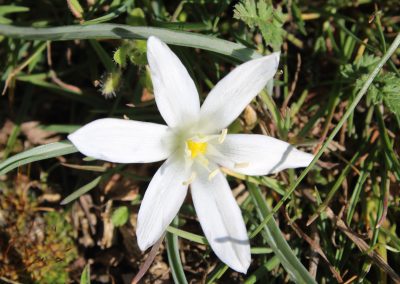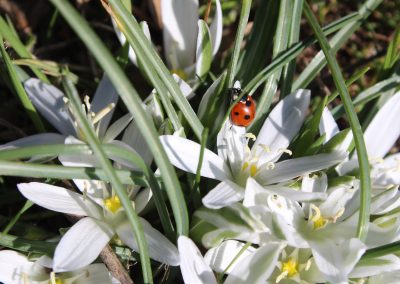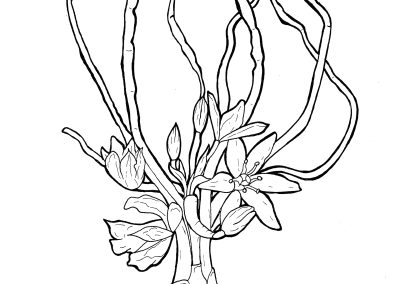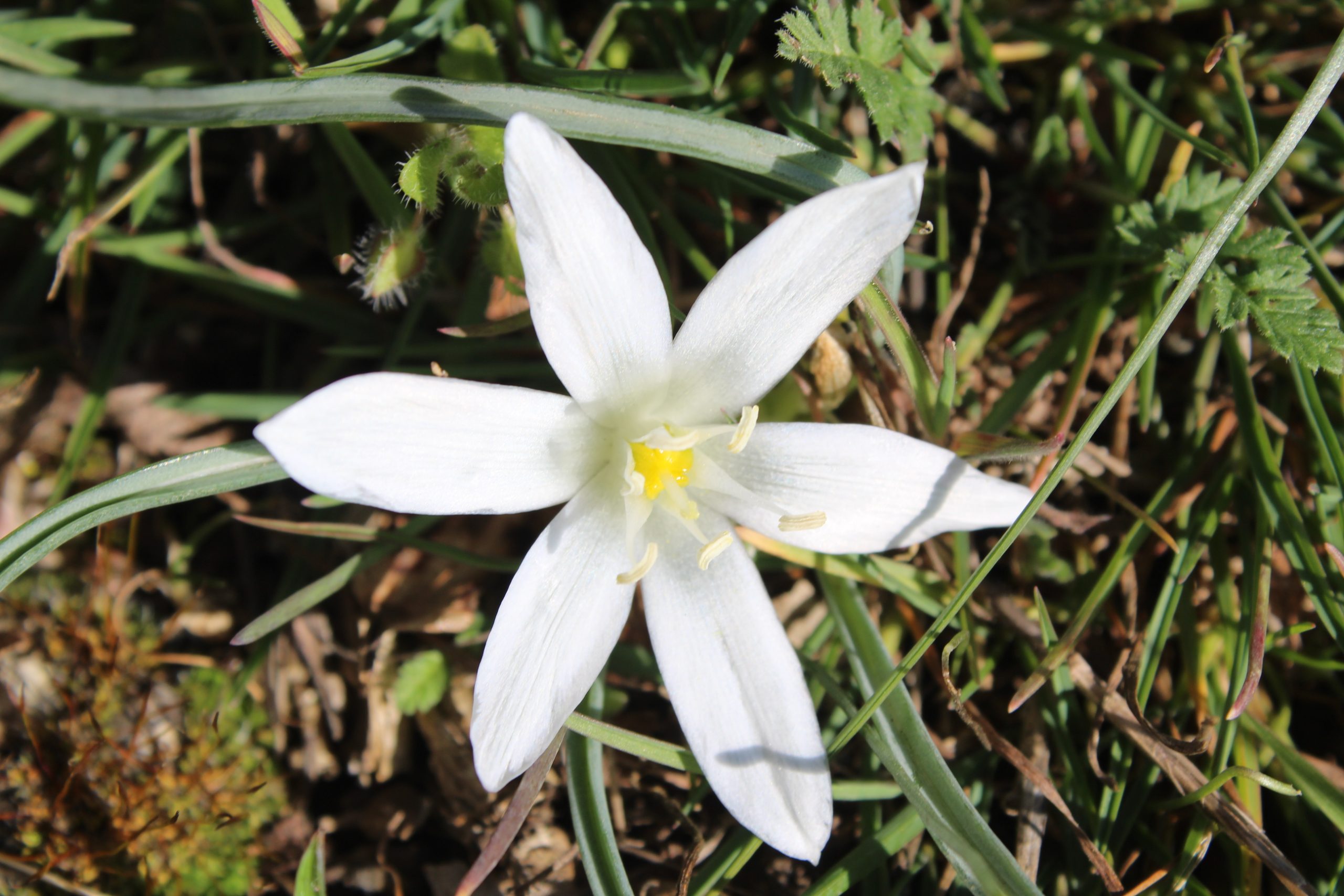Ornithogalum
Scientific description
Ornithogalum Sibthorpii
Taxon: Angiospermatophyta (Magnoliophyta)
Class: Monocotyledonatae (Liliatae)
Subclass: Liliidae
Order: Liliales
Family: Liliaceae
Origin: Europe and Asia
Common name: Crow Onion
Description:
Herbaceous, perennial plant with a white bulb, 5–15 cm tall. Leaves linear, channeled, white midrib. Flowers white, opening in the morning, closing in the afternoon, arranged in terminal corymbs on small stems. Flowers 8–15 mm, lower flowers larger, star-shaped. Blooms March–April. Rare species in Dobrogea, xerophytic, important for biodiversity in rocky areas.
Propagation: Bulbs and seeds.
Ecology:
Grows on arid slopes, sandy shores, arid meadows on rocky subsoil, from silvostepic areas to oak forests.
Use:
Planted in gardens and parks as decorative in semi-shaded areas with clay-sandy soil.
Threat:
Rare species in Dobrogea, listed in Red List of superior plants of Romania (Oltean et al., 1994).
Ornithogalum sibthorpii
Încrengătura: Angiospermatophyta (Magnoliophyta)
Clasa: Monocotyledonatae (Liliatae)
Subclasa: Liliidae
Ordinul: Liliales
Familia: Liliacee
Origine: Europa și Asia
Denumire populară: ceapa ciorii
Descrierea:
Plantă erbacee, perenă cu bulb alb, 5–15 cm. Frunzele liniare, canaliculate, nervură mediană albă. Florile albe, se deschid dimineața și se închid după-amiaza, dispuse în corimbe terminale pe tulpini scurte. Florile 8–15 mm, inferioare mai mari, în formă de stea. Înflorește martie–aprilie. Specie rară în Dobrogea, xerofitică, componentă de bază a diversității biologice în zone stâncoase.
Înmulțire: Bulbi și semințe.
Ecologia:
Crește pe coaste aride, nisipuri de litoral, pajiști aride pe substrat pietros, din zona silvostepei până în pădurile de stejar.
Utilizare:
Plantată în grădini și parcuri ca decorativă în zone semi-umbrite cu sol argilo-nisipos.
Pericol:
Specie rară în Dobrogea, menționată în Lista Roșie a plantelor superioare din România (Oltean et al., 1994).
Ornithogalum sibthorpii - Ορνιθόγαλο του Σίμπθορπ
Φυλοταξία: Angiospermatophyta (Magnoliophyta)
Κλάση: Monocotyledonatae (Liliatae)
Υποκλάση: Liliidae
Τάξη: Liliales
Οικογένεια: Liliaceae
Καθημερινή Ονομασία: Κρεμμύδι της κότας
Περιγραφή:
Πολυετές φυτό με λευκό βολβό, ύψος 5–15 εκ. Φύλλα γραμμικά, με λευκή κεντρική νεύρωση. Άνθη λευκά, ανοίγουν πρωί, κλείνουν απόγευμα, σε τελικές ταξιανθίες πάνω σε μικρούς μίσχους. Άνθη 8–15 mm, κατώτερα μεγαλύτερα, αστεροειδή. Ανθίζει Μάρτιο–Απρίλιο. Σπάνιο στη Δοβρουτζά, ξηρόφιλο, σημαντικό για βιοποικιλότητα σε βραχώδεις περιοχές.
Αναπαραγωγή: Βολβοί και σπόροι.
Οικολογία:
Αναπτύσσεται σε ξηρές πλαγιές, αμμώδεις ακτές, ξηρές λιβάδια σε πετρώδες υπόστρωμα, από ζώνη σιλβοστέπας έως δάση βελανιδιάς.
Χρήση:
Φυτεύεται σε κήπους και πάρκα ως διακοσμητικό σε ημισκιερές περιοχές με αργιλο-αμμώδη εδάφη.
Κίνδυνος:
Σπάνιο είδος στη Δοβρουτζά, αναφέρεται στην Κόκκινη Λίστα των Υπερφυσικών Φυτών της Ρουμανίας (Oltean et al., 1994). Προστατευόμενο είδος.
Ornithogalum Sibthorpii
Taxon : Angiospermatophyta (Magnoliophyta)
Classe : Monocotylédones (Liliacées) Monocotyledonatae (Liliatae)
Sous-classe : Liliidae
Ordre : Liliales
Famille : Liliaceae
Origine : Europe et Asie
Nom commun : Oignon corbeau
Description :
Plante herbacée vivace avec bulbe blanc, 5–15 cm. Feuilles linéaires, cannelées, nervure centrale blanche. Fleurs blanches, s'ouvrant le matin, se refermant l'après-midi, disposées en corymbes terminaux sur petites tiges. Fleurs 8–15 mm, inférieures plus grandes, en étoile. Fleurit mars–avril. Espèce rare en Dobrogea, xérophile, élément clé de biodiversité sur zones rocheuses.
Propagation : Bulbes et graines.
Écologie :
Pentes arides, rivages sablonneux, prairies arides sur sous-sol rocheux, de la zone silvostépique aux forêts de chênes.
Utilisation :
Plantée dans jardins et parcs comme décorative dans zones semi-ombragées avec sol argilo-sableux.
Menace :
Espèce rare en Dobrogea, mentionnée dans la liste rouge des plantes supérieures de Roumanie (Oltean et al., 1994). Protégée.
Creative writing inspired by Ornithogalum
Written by
Andreea Tote
Andrada-Alexandra Lica
The Two-Faced Flower
Long ago, in a rocky land swept by bitter winds and forgotten legends, there lived a girl named Colcha. She was quiet, slender like a flower’s stem, with hair as white as late snow and eyes as dark as the night. She lived with her mother, a woman known across villages as “the one who knows herbs.”
But Colcha was no ordinary girl. Born on a moonless night, it was whispered she carried an ancient fate, passed down from a forgotten ancestor - the witch Medea, daughter of the King of Colchis, who once poisoned dragons for love and lost everything in return.
One day, a nobleman from a nearby city came to their home. He saw Colcha and said, “I will take her as my wife. A girl like that shouldn’t be hidden.” Her mother refused him, but he left with threats in his mouth and fire in his eyes.
That night, Colcha said softly, “Mother, I am no man’s prize. I would rather wither than be torn from my roots.”
The old woman was silent for a while. Then, from her wooden chest, she took out a small white seed. “This is a rare flower. People call it the crow’s onion. Beautiful - but inside it flows both remedy and ruin. You must choose how to use it.”
Colcha took the seed. The next day, when the man returned, she met him at the door with a steaming cup of tea. No one knows what she said to him, but he never spoke of her again.
That spring, in the meadow where Colcha used to gather herbs, small white flowers began to bloom - fragile, star-shaped, and faintly sweet, yet bitter in scent. They grew in silence, in pairs, and faded quickly, like a whispered warning that no one dared finish.
Some say the flower is a curse. Others, a cure. But those who know Colcha’s story say it carries both: the fight and the peace. And that the crow’s onion, like the girl herself, is beautiful, dangerous, and free.


